Thu 5 Dec 2013
MIKE NEVINS’ End-of-Year Column: Six Archived Reviews.
Posted by Steve under Columns , Reviews[5] Comments
by Francis M. Nevins
During the late Sixties and early Seventies I seem to have developed the habit of reading, and writing up for my eyes only, a number of first mystery novels (either for an author or a byline) that for the most part I admired. Restricting myself to books by dead Americans that were first published under pseudonyms never seen before, I venture to cobble together my end-of-year column out of this ancient raw material.
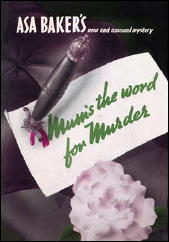
The year before Davis Dresser (1904-1977) began using the name of Brett Halliday for his endlessly running Michael Shayne private eye series, he created a byline all but unknown today to chronicle the cases — all two of them — of Jerry Burke, an El Paso police administrator who favors brainwork over PI tactics.
In MUM’S THE WORD FOR MURDER, as by Asa Baker (Stokes, 1938), his adversary is a serial-killer who advertises in the local paper, daring Burke to stop him. After three apparently unconnected murders our hero comes up with a neat solution which is also found in at least three later crime novels much more familiar to readers than this one. (I’d be a toad if I revealed their titles or authors.)
Occasional realistic insights into poverty, anti-Mexican racism and literary amateurs make up for the ill-informed excursions into law and psychoanalysis. That the book Burke’s Watson is trying to write turns out to be the book we’re reading adds a Pirandelloesque fillip to a fine fast-moving unpretentious novel, which of course was reprinted as by Brett Halliday after that name had become a staple item in the genre.
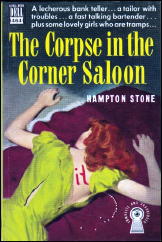
Aaron Marc Stein (1906-1985) had been writing whodunits since 1935, first as George Bagby and then also under his own name. After wartime service as an Army cryptographer he launched a second pseudonym and a third series. THE CORPSE IN THE CORNER SALOON, as by Hampton Stone (Simon & Schuster, 1948), introduces Gibson and Mac, two investigators from the New York District Attorney’s office who get assigned to a case of apparent murder and suicide with grotesque sexual overtones.
Along with a raft of suspects and some deftly juggled criminal possibilities we are offered knowing evocations of the postwar clothing business, the old-style saloon milieu, and the postwar apartment shortage. The solution is so nobly complicated that I shrugged off the few loose strands of plot and the sniggering tone of the sex passages as minor annoyances.
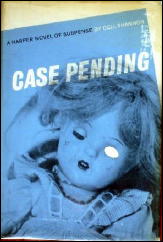
Elizabeth Linington (1921-1988) wrote whodunits under her own name and several pseudonyms, each book being written in about two weeks. In CASE PENDING, as by Dell Shannon (Harper, 1960), she introduced Lt. Luis Mendoza, an arrogant, amorous, brilliantly intuitive LAPD Homicide detective who senses, and almost succeeds in tracking down, the link between two unconnected female corpses each with one eye mutilated.
Shannon interweaves the murder case with counterplots involving illegal adoption, the planned disposal of a blackmailer, a narcotics drop, and Mendoza’s pursuit of a bemused charm school instructor, but in every part of the book she irritates us by recording characters’ thoughts in the same monotonous ungrammatical shorthand they use when they speak.
On the plus side she has a gift for probing agonized minds (a 13-year-old boy who knows too much, a petty civil servant plotting the perfect murder), for adopting at least some of the values of the strict detective novel, and for presenting an explicit atheistic viewpoint without pretentiousness or propagandizing.
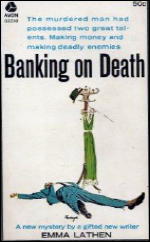
Emma Lathen, the joint pseudonym of Mary Jane Latsis (1927-1997) and Martha Henissart (1929- ), first appeared on the spine of BANKING ON DEATH (Macmillan, 1961), in which John Putnam Thatcher, vice-president of a prestigious Wall Street bank, has to elucidate a murder problem with ramifications in New York City, Buffalo, Boston and Washington.
The bank’s search for a missing trust fund beneficiary ends with the discovery that he’s been bludgeoned to death in the middle of a blizzard, and its duties as trustee require Thatcher to take a hand in the investigation.
The characters and writing are nothing special but there are fine evocations of Wall Street, Brahmin elitism, and the curious behavior of airports during snowstorms, and the deductive puzzle is neatly constructed.
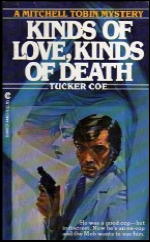
It certainly wasn’t his first novel, but KINDS OF LOVE, KINDS OF DEATH, as by Tucker Coe (Random House, 1966), introduced a new byline and a new series character for prolific Donald E. Westlake (1933-2008).
A Syndicate boss who for obvious reasons can’t go to the police hires disgraced ex-cop Mitch Tobin to take a break from building a high wall around his house and find out who inside the “corporation†first seduced his lover and then murdered her.
The trail to the truth is basically psychological and unmarked by incidents of violence. Tobin guesses right far too often and the killer turns out to be a walk-on part, but Coe deals skillfully with a variety of failed relationships and unsentimentally with the insight that professional criminals are no different from other successful American businessmen.
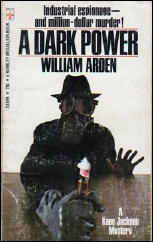
A DARK POWER, as by William Arden (Dodd Mead, 1968), was also not a debut novel except in the sense that, like KINDS OF LOVE, KINDS OF DEATH, it introduced a new byline and a new series character for its author, the equally prolific Dennis Lynds (1924-2005).
Industrial spy Kane Jackson, who seems to have been modeled on Lee Marvin’s screen persona, is hired by a New Jersey pharmaceutical combine to recover a missing sample of a drug potentially worth millions. The trail leads through mazes of inter-office love affairs and power struggles and several bodies, some naked and others dead, come into view along the way.
Arden meshes his counterplots with precision, draws several vivid characters trapped by their own ambitions in the jungle of high-level capitalism, and caps the story with a double surprise climax. The plot is resolved by clever guesswork but that’s the only weakness in this admirably tough-minded whodunit.
I’ve just discovered on the Web that half of Emma Lathen seems to be still alive, which means that I haven’t completely restricted myself to the dead. But I also discovered, while combing through comments I first typed up on my trusty Olympia Portable almost half a century ago, that I have enough material for January 2014 if the seasonal blahs continue to get me down.
Next time the subject will be American debut novels published under their authors’ own names. Meanwhile, until I cobble together my first column of the new year, happy holidays to all who may see this one.
December 5th, 2013 at 9:30 pm
By a remarkable coincidence I’ve read everyone of these, including the Dresser/Halliday book in the Burke version. Mike nails them all accurately.
Arden and Tobin were interesting variations on the traditional private eye character. The Tobin book is better, but both good reads.
I think I actually preferred Stein writing as Stein, he not only had Matt Erridge, but a husband and wife team of archeologists who also globetrotted while sleuthing. That said, the Schmidt books and the Hampton Stone series were both solid with flashes of what Stein might have done beyond the mid-list (which was no bad place to be).
December 6th, 2013 at 10:20 am
I’ve read books by each of these authors, although technically speaking, not “Äsa Baker” nor “Hampton Stone,:but not any of these specific titles. The Mac and Gibby books are ones that I regret the most never taking a sample of. If you do a search on this blog for either Stein or Bagby, you’ll find a ton of titles reviewed and discussed, many by me.
December 6th, 2013 at 11:28 am
I’ll have to take back my comment above. I don’t remember it in any kind of detail, but I did read all of the books in Westlake’s Tucker Coe series as soon as they came out, including this first one. It’s a series that works on all kinds of levels, but when the end came, it was obvious that there wouldn’t be any more.
December 6th, 2013 at 12:08 pm
Never knew about the Asa Baker book. Will have to hunt down a copy.
I’ve read only one of Elizabeth Linington’s books and have no desire to pursue her further. She was dubbed “Queen of the Police Procedruals” but based on reviews of others who were brave enough to read more of her work than I she hasn’t a clue how a police station works. There is no evidence of real police procedure in her so-called police procedurals. Like Mike I also was annoyed by her eccentric stylistics. In a review of GREENMASK! I wrote: “The dialogue is rendered with many interrupted thoughts, lots of dashes and ellipses. All of the characters interviewed by the police talk this way. Only the police seem to be able to speak in full sentences without being distracted. By midway into the book you just hope for two or three pages of easy dialogue exchanges without someone going off into a non sequitar monologue. Linington reaches hyperrealism overload at the expense of a good story.” Her convervative often bigoted political views tend to bleed into her books, too, so I hear. Her hateful view of gay people in GREENMASK! was evidence enough for me to avoid her.
The Mitch Tobin novels are ground breakers, I think. Paved the way for Wambaugh’s complex cops with emotional problems reltaed to the violence they face in their jobs. JADE IN ARIES surprised me as being one of the most compassionate crime novels dealing with gay life.
I’ve not read any of the other writers. Based on the review of the Hampton Stone, who has tempted me once or twice, I may try one of his books.
December 6th, 2013 at 9:11 pm
Agree on Linnington/Shannon. Her politics and her style put me off.
Tobin is one of the more significant eyes of his era, and perhaps of the genre. Westlake brought not only his considerable skills, but a novelistic touch to the series, though I’ve always wondered if he intended it to be a closed series from the start, or if he felt he couldn’t continue the series at the high level he had been working at and continue with his more popular books under his own name and Richard Stark.
I’m just grateful we have the ones we do.
Agree about JADE IN AIRIES, which might have been the first book I ever read that dealt not only sympathetically with gay people and the culture. Certainly I don’t recall anyone else dealing that openly with the subject in the genre then, though wasn’t that about the time Joseph Hansen’s Dave Brandsetter appeared?
Tobin was a complex character, not an anti-hero by any means, but not a cut and dried good guy boy scout either. The books represent an interesting arc that Westlake may have thought provided a natural conclusion.
I caught up with the Mac and Gibby books in paperback finally, and can affirm it was a bright snappy series that somehow managed to avoid becoming overly familiar by sheer skill at the genre.
Other than a few I picked up here and there I never had much access to the Schmidt books, but I recall some critical praise for the series. Yet another mid-lister who I suspected could have broken out with the right book at the right time.